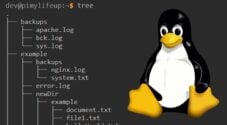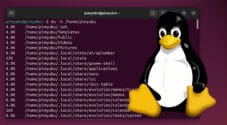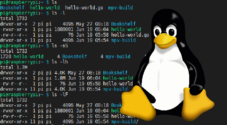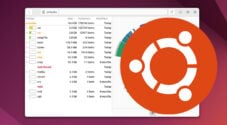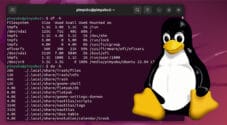In this tutorial, we cover the basics of using the df command on a Linux-based distribution.
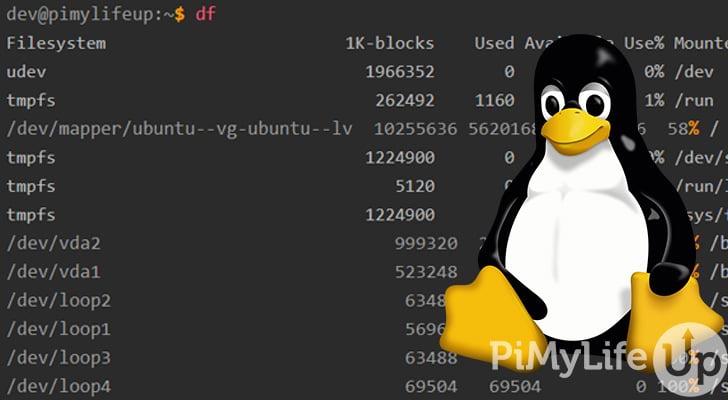
The df command is short for disk filesystem and will display statistics on the current state of a file system. For example, you can view used, total, and available disk space. Also, you can use the command to view filesystem types, the mount point, and much more.
This command is extremely useful whenever you need to find more information regarding disk usage space on a Linux distribution. Using the human-readable option, you can quickly see how much space your file systems have left.
Below we will take you through using the df command on Linux systems. We cover topics such as using the command to view inodes, total size, display hidden filesystems, and much more.
Table of Contents
df command Syntax
The syntax for the df command is straightforward to understand, accepting only two arguments.
df [OPTIONS] [FILE]Copy- [OPTIONS] is where you specify any additional options that you would like applied to the command. We go through some of the different options you can use with the df command further down this page.
- [FILE] is where you specify the file name for which you need the file system information. It is optional and can accept multiple file names. If you do not specify a filename, df will display information for all mounted file systems.
df command Options
Below are most of the options you can use with the df command. We go into more detail about some of the options further on in this tutorial.
-aor--allwill output duplicate, pseudo, and inaccessible file systems.-B SIZEor--block-size=SIZEscales the sizes by the input size.-hor--human-readableprints the sizes in a human-readable format. The sizes are in the power of 1020.-Hor--siare the same as the option above, but the sizes are in the power of 1000.-ior--inodeswill list inode usage information instead of the block usage information.-lor--locallimits the results to local file systems. Otherwise, the default behavior of the command will display remote file systems.--no-syncdisables the sync system call before getting data. It increases the speed of the command, but the results may be out of date. This option is on by default.--output=[FIELD_LIST]allows you to change the columns outputted for the file system information. Replace[FIELD_LIST]with a comma-separated list of fields you wish to be outputted. We touch on the columns you can use in the column section on this page.--syncforces a sync before getting data. It can slow the speed of command, but the results should be more accurate.--totaldisplays a total of all the filesystem sizes after processing them.-t TYPEor--type=TYPEallows you to limit the file systems to a particular TYPE.-x TYPEor--exclude-type=TYPEallows you to exclude a specific TYPE.
Default df Columns
The example output below shows the default column headers and an example line. I will quickly explain each of the headers underneath the example.
Filesystem 1K-blocks Used Available Use% Mounted on
udev 1966352 0 1966352 0% /dev
CopyFilesystemis the source of the mount point. Typically it is a device.Sizeoutputs the total number of blocks.Usedis the number of used blocks.Availis the number of available blocks you can use.Use%displays the percentage calculated by dividing used by size.Mounted onis the mount point.
You can use the --output=[FIELD_LIST] to customize the fields displayed in the output. Below are all the options you can use.
sourceis the source of the mount point and typically is a device. It is the same as thefilesystemcolumn.fstypeoutputs the file system type.itotaldisplays the total number of inodes.iusedis the number of used inodes.iavailoutputs the total number of available inodes.ipcentdisplays the percentage calculated by dividing “iused” by “isize“.sizeoutputs the total number of blocks.usedis the total number of used blocks.availis the number of available blocks you can use.pcentdisplays the percentage calculated by dividing used by size. It is the same as theuse%column in the default command.filedisplays the filename, if it is specified in the command line.targetis the mount point. It is the same as themounted oncolumn.
Using the df Command
The df command is super easy to use, making it perfect for quickly checking the disk filesystem. This tutorial will take you through how to use the df command and many of its options. To start will cover how to use the basic command.
Basic Usage
To run the df command without any filenames or options, simply write df into the terminal.
dfCopyBy default, df will output a report showing the space used and available on all the mounted file systems.
dev@pimylifeup:~$ df
Filesystem 1K-blocks Used Available Use% Mounted on
udev 1966352 0 1966352 0% /dev
tmpfs 262492 1160 261332 1% /run
/dev/mapper/ubuntu--vg-ubuntu--lv 10255636 5620168 4094796 58% /
tmpfs 1224900 0 1224900 0% /dev/shm
tmpfs 5120 0 5120 0% /run/lock
tmpfs 1224900 0 1224900 0% /sys/fs/cgroup
/dev/vda2 999320 212072 718436 23% /boot
/dev/vda1 523248 5356 517892 2% /boot/efi
/dev/loop2 63488 63488 0 100% /snap/core20/1405
/dev/loop1 56960 56960 0 100% /snap/core18/2344
/dev/loop3 63488 63488 0 100% /snap/core20/1434
/dev/loop4 69504 69504 0 100% /snap/lxd/22753
/dev/loop5 45824 45824 0 100% /snap/snapd/15534
/dev/loop6 69632 69632 0 100% /snap/lxd/22526
/dev/loop7 44800 44800 0 100% /snap/snapd/15177
/dev/loop8 56960 56960 0 100% /snap/core18/2409
tmpfs 244980 0 244980 0% /run/user/1000CopyDisplay All
If you would like duplicate, pseudo, and inaccessible file systems included in the output, you will need to use the -a or --all option.
df -allCopyIn the output below, you can see it has printed a lot of file systems and their information. Unfortunately, most of our hidden, pseudo, and inaccessible file systems do not have a significant amount of information alongside them.
dev@pimylifeup:~$ df -all
Filesystem 1K-blocks Used Available Use% Mounted on
sysfs 0 0 0 - /sys
proc 0 0 0 - /proc
udev 1966352 0 1966352 0% /dev
devpts 0 0 0 - /dev/pts
tmpfs 262492 1160 261332 1% /run
/dev/mapper/ubuntu--vg-ubuntu--lv 10255636 5620168 4094796 58% /
securityfs 0 0 0 - /sys/kernel/security
tmpfs 1224900 0 1224900 0% /dev/shm
tmpfs 5120 0 5120 0% /run/lock
tmpfs 1224900 0 1224900 0% /sys/fs/cgroup
cgroup2 0 0 0 - /sys/fs/cgroup/unified
cgroup 0 0 0 - /sys/fs/cgroup/systemd
pstore 0 0 0 - /sys/fs/pstore
efivarfs 0 0 0 - /sys/firmware/efi/efivars
none 0 0 0 - /sys/fs/bpf
cgroup 0 0 0 - /sys/fs/cgroup/pids
cgroup 0 0 0 - /sys/fs/cgroup/net_cls,net_prio
cgroup 0 0 0 - /sys/fs/cgroup/memory
cgroup 0 0 0 - /sys/fs/cgroup/freezer
cgroup 0 0 0 - /sys/fs/cgroup/cpu,cpuacct
cgroup 0 0 0 - /sys/fs/cgroup/perf_event
cgroup 0 0 0 - /sys/fs/cgroup/cpuset
cgroup 0 0 0 - /sys/fs/cgroup/hugetlb
cgroup 0 0 0 - /sys/fs/cgroup/blkio
cgroup 0 0 0 - /sys/fs/cgroup/rdma
cgroup 0 0 0 - /sys/fs/cgroup/devices
systemd-1 0 0 0 - /proc/sys/fs/binfmt_misc
hugetlbfs 0 0 0 - /dev/hugepages
mqueue 0 0 0 - /dev/mqueue
debugfs 0 0 0 - /sys/kernel/debug
tracefs 0 0 0 - /sys/kernel/tracing
fusectl 0 0 0 - /sys/fs/fuse/connections
configfs 0 0 0 - /sys/kernel/config
/dev/vda2 999320 212072 718436 23% /boot
/dev/vda1 523248 5356 517892 2% /boot/efi
/dev/loop2 63488 63488 0 100% /snap/core20/1405
/dev/loop1 56960 56960 0 100% /snap/core18/2344
/dev/loop3 63488 63488 0 100% /snap/core20/1434
/dev/loop4 69504 69504 0 100% /snap/lxd/22753
/dev/loop5 45824 45824 0 100% /snap/snapd/15534
/dev/loop6 69632 69632 0 100% /snap/lxd/22526
/dev/loop7 44800 44800 0 100% /snap/snapd/15177
tmpfs 262492 1160 261332 1% /run/snapd/ns
nsfs 0 0 0 - /run/snapd/ns/lxd.mnt
/dev/loop8 56960 56960 0 100% /snap/core18/2409
tmpfs 244980 0 244980 0% /run/user/1000
CopyOutput Total Size
Using the --total option will print out a total of each of the columns once they have been processed. It is useful for finding out the total of the size, used, and available columns.
df --totalCopyIn the output below, you will see a total row at the bottom. This row contains the totals for each column.
dev@pimylifeup:~$ df --total
Filesystem 1K-blocks Used Available Use% Mounted on
udev 1966352 0 1966352 0% /dev
tmpfs 262492 1160 261332 1% /run
/dev/mapper/ubuntu--vg-ubuntu--lv 10255636 5620168 4094796 58% /
tmpfs 1224900 0 1224900 0% /dev/shm
tmpfs 5120 0 5120 0% /run/lock
tmpfs 1224900 0 1224900 0% /sys/fs/cgroup
/dev/vda2 999320 212072 718436 23% /boot
/dev/vda1 523248 5356 517892 2% /boot/efi
/dev/loop2 63488 63488 0 100% /snap/core20/1405
/dev/loop1 56960 56960 0 100% /snap/core18/2344
/dev/loop3 63488 63488 0 100% /snap/core20/1434
/dev/loop4 69504 69504 0 100% /snap/lxd/22753
/dev/loop5 45824 45824 0 100% /snap/snapd/15534
/dev/loop6 69632 69632 0 100% /snap/lxd/22526
/dev/loop7 44800 44800 0 100% /snap/snapd/15177
/dev/loop8 56960 56960 0 100% /snap/core18/2409
tmpfs 244980 0 244980 0% /run/user/1000
total 17177604 6309412 10258708 39% -
Number of Free inodes
By default, df will provide the statistics based on block usage. However, if you rather use inodes (index node), you can use the -i or --inodes option. An inode stores data about a Linux file, such as owner, permissions, timestamps, and more.
df --inodesCopyThe output below demonstrates using inodes instead of blocks. The column headings will update to reflect that they contain inodes.
dev@pimylifeup:~$ df --inodes
Filesystem Inodes IUsed IFree IUse% Mounted on
udev 491588 477 491111 1% /dev
tmpfs 328113 741 327372 1% /run
/dev/mapper/ubuntu--vg-ubuntu--lv 655360 117753 537607 18% /
tmpfs 306225 1 306224 1% /dev/shm
tmpfs 306225 3 306222 1% /run/lock
tmpfs 306225 18 306207 1% /sys/fs/cgroup
/dev/vda2 65536 308 65228 1% /boot
/dev/vda1 0 0 0 - /boot/efi
/dev/loop2 11778 11778 0 100% /snap/core20/1405
/dev/loop1 10849 10849 0 100% /snap/core18/2344
/dev/loop3 11789 11789 0 100% /snap/core20/1434
/dev/loop4 802 802 0 100% /snap/lxd/22753
/dev/loop5 484 484 0 100% /snap/snapd/15534
/dev/loop6 799 799 0 100% /snap/lxd/22526
/dev/loop7 482 482 0 100% /snap/snapd/15177
/dev/loop8 10857 10857 0 100% /snap/core18/2409
tmpfs 306225 22 306203 1% /run/user/1000
CopyPrint File System Type
If you require the file system type with the rest of the information, you can use the -T or --print-type option. These are the same file system types that you can include or exclude using additional options that we will explain next.
df -TCopyIn the output below, you can see a new column called type that contains a range of different file system types. Other types that you might see here include nfs, ext2, ext3, xfs, brfs, iso9660, cdfs, ntfs, fat, and much more.
dev@pimylifeup:~$ df -T
Filesystem Type 1K-blocks Used Available Use% Mounted on
udev devtmpfs 1966352 0 1966352 0% /dev
tmpfs tmpfs 262492 1160 261332 1% /run
/dev/mapper/ubuntu--vg-ubuntu--lv ext4 10255636 5620168 4094796 58% /
tmpfs tmpfs 1224900 0 1224900 0% /dev/shm
tmpfs tmpfs 5120 0 5120 0% /run/lock
tmpfs tmpfs 1224900 0 1224900 0% /sys/fs/cgroup
/dev/vda2 ext4 999320 212072 718436 23% /boot
/dev/vda1 vfat 523248 5356 517892 2% /boot/efi
/dev/loop2 squashfs 63488 63488 0 100% /snap/core20/1405
/dev/loop1 squashfs 56960 56960 0 100% /snap/core18/2344
/dev/loop3 squashfs 63488 63488 0 100% /snap/core20/1434
/dev/loop4 squashfs 69504 69504 0 100% /snap/lxd/22753
/dev/loop5 squashfs 45824 45824 0 100% /snap/snapd/15534
/dev/loop6 squashfs 69632 69632 0 100% /snap/lxd/22526
/dev/loop7 squashfs 44800 44800 0 100% /snap/snapd/15177
/dev/loop8 squashfs 56960 56960 0 100% /snap/core18/2409
tmpfs tmpfs 244980 0 244980 0% /run/user/1000CopyLimit File System Type
It is possible to limit the results to a particular file system type. To do this, simply use the -t FSTYPE or --type=FSTYPE option replacing FSTYPE with the file system type you want to view.
In the example below, we want to limit our results to the file system type of devtmpfs.
df -t devtmpfsCopyYou can see one result in the output below as it is the only filesystem using the specified file system type. You can confirm this by using the -T option.
dev@pimylifeup:~$ df -t devtmpfs
Filesystem 1K-blocks Used Available Use% Mounted on
udev 1966352 0 1966352 0% /devCopyExclude File System Type
You can use the -x FSTYPE or --exclude-type=FSTYPE options to exclude a file system type from displaying. Replace FSTYPE with the file system type you wish excluded from your results.
Our example below will remove all entries that use the squashfs file system type.
df -x squashfsCopyThe output below is missing any filesystem using the squashfs type. Notably, all the excluded filesystems are mounted within the /snap/ directory.
dev@pimylifeup:~$ df -x squashfs
Filesystem 1K-blocks Used Available Use% Mounted on
udev 1966352 0 1966352 0% /dev
tmpfs 262492 1160 261332 1% /run
/dev/mapper/ubuntu--vg-ubuntu--lv 10255636 5620172 4094792 58% /
tmpfs 1224900 0 1224900 0% /dev/shm
tmpfs 5120 0 5120 0% /run/lock
tmpfs 1224900 0 1224900 0% /sys/fs/cgroup
/dev/vda2 999320 212072 718436 23% /boot
/dev/vda1 523248 5356 517892 2% /boot/efi
tmpfs 244980 0 244980 0% /run/user/1000CopyOutput Human Readable Sizes
You can use the -h or --human-readable option to make the sizes human-readable. By using either of these options, powers of 1024 are used for the size. Using powers of 1024 means the sizes will be in Kibibyte, Mebibyte, Gibibyte, and Tebibyte.
df -hCopyAs you can see in the output below, the sizes are easier to read and understand.
dev@pimylifeup:~$ df -h
Filesystem Size Used Avail Use% Mounted on
udev 1.9G 0 1.9G 0% /dev
tmpfs 257M 1.2M 256M 1% /run
/dev/mapper/ubuntu--vg-ubuntu--lv 9.8G 5.4G 4.0G 58% /
tmpfs 1.2G 0 1.2G 0% /dev/shm
tmpfs 5.0M 0 5.0M 0% /run/lock
tmpfs 1.2G 0 1.2G 0% /sys/fs/cgroup
/dev/vda2 976M 208M 702M 23% /boot
/dev/vda1 511M 5.3M 506M 2% /boot/efi
/dev/loop2 62M 62M 0 100% /snap/core20/1405
/dev/loop1 56M 56M 0 100% /snap/core18/2344
/dev/loop3 62M 62M 0 100% /snap/core20/1434
/dev/loop4 68M 68M 0 100% /snap/lxd/22753
/dev/loop5 45M 45M 0 100% /snap/snapd/15534
/dev/loop6 68M 68M 0 100% /snap/lxd/22526
/dev/loop7 44M 44M 0 100% /snap/snapd/15177
/dev/loop8 56M 56M 0 100% /snap/core18/2409
tmpfs 240M 0 240M 0% /run/user/1000
CopyAlternatively, if you prefer powers of 1000, you can use the --si or -H option. Using powers of 1000 means the sizes will be Kilobyte, Megabyte, Gigabyte, and Terabyte.
df --siCopyThe output below shows the sizes using the power of 1000. Using these options makes it easier to understand the file system size and available space.
dev@pimylifeup:~$ df --si
Filesystem Size Used Avail Use% Mounted on
udev 2.1G 0 2.1G 0% /dev
tmpfs 269M 1.2M 268M 1% /run
/dev/mapper/ubuntu--vg-ubuntu--lv 11G 5.8G 4.2G 58% /
tmpfs 1.3G 0 1.3G 0% /dev/shm
tmpfs 5.3M 0 5.3M 0% /run/lock
tmpfs 1.3G 0 1.3G 0% /sys/fs/cgroup
/dev/vda2 1.1G 218M 736M 23% /boot
/dev/vda1 536M 5.5M 531M 2% /boot/efi
/dev/loop2 66M 66M 0 100% /snap/core20/1405
/dev/loop1 59M 59M 0 100% /snap/core18/2344
/dev/loop3 66M 66M 0 100% /snap/core20/1434
/dev/loop4 72M 72M 0 100% /snap/lxd/22753
/dev/loop5 47M 47M 0 100% /snap/snapd/15534
/dev/loop6 72M 72M 0 100% /snap/lxd/22526
/dev/loop7 46M 46M 0 100% /snap/snapd/15177
/dev/loop8 59M 59M 0 100% /snap/core18/2409
tmpfs 251M 0 251M 0% /run/user/1000CopyMore Help
If you require more help with the df command and its options, there are a couple of easy ways to get more information.
The first method is to use the manual tool that is built into most Linux operating systems. Simply write man followed by the command.
man dfCopyYou can exit the manual document by pressing q.
The second method uses the commands inbuilt help option. Simply write --help after the command, as shown in the example below.
df --helpCopyI hope either of the above methods helps you get the information you require.
Conclusion
I hope by now you have a decent understanding of how to use the df command and its options. It is an extremely useful command for understanding the current state of the file system.
If you are planning to use Linux-based distributions a lot, I highly recommend that you take the time to learn some of the other Linux commands you can use. It will make life a lot easier when administrating a Linux distribution.
Please let us know if you notice a mistake or if an important topic is missing from this guide.




